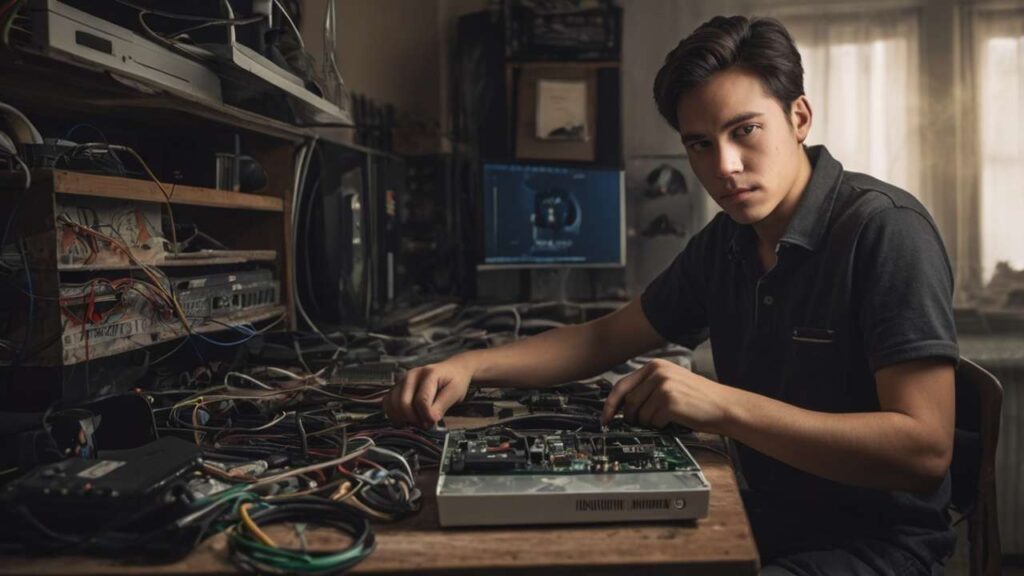Most gamers don’t think about the health of their consoles until it’s too late. The device powers off in the middle of a match, or it sounds like a jet engine ready for takeoff. By then, the repair bill is often unavoidable. That’s why talking about 5 Simple Habits to Double Your Console’s Lifespan (Pro Prevention Tips) isn’t boring—it’s survival for your gaming setup.
A console breakdown doesn’t just ruin your night; it can cost hundreds of dollars and weeks of waiting. And the wild thing? Most of these problems could have been avoided with simple habits you can apply at home. I’ve learned this the hard way—my old PS4 died because I ignored dust buildup for months. It’s frustrating because a ten-minute cleaning routine would have saved me from replacing it.
- Dust: The Silent Console Killer
- Protect Against Power Surges
- Cable Handling Matters More Than You Think
- Venting: Give Your Console Room to Breathe
- Stay Updated with Firmware
- Why Prevention Beats Repair Every Time
- A Real Case Study: Two Gamers, Two Outcomes
- Looking Ahead: Future Conversations in Console Care
- FAQs
Dust: The Silent Console Killer
Dust is like kryptonite for electronics. It clogs vents, overheats fans, and forces your system to work harder. Over time, dust literally chokes your console until performance tanks. Experts call it the “slow death” of gaming hardware.
One professional repair specialist from Best Gaming Console Repair Recommendations in North Carolina explained: “Most consoles that come into our shop with overheating issues aren’t broken—they’re just dirty. A basic cleaning could have prevented 70% of them.”
It’s not rocket science. Use a soft brush, canned air, or even a low-power vacuum attachment to keep vents clear. Just don’t go wild—forceful air can spin the fans too fast and damage bearings. I’ve seen people do this and regret it immediately.
Ignoring dust leads directly into problems like the infamous “jet engine” noise. That screaming fan sound is a sign your console is suffocating. Related posts like The Jet Engine Console: Signs You Need PS4/Xbox/Switch Thermal Paste and Fan Cleaning explain how professionals strip the system down, replace thermal paste, and restore cooling. But if you maintain it regularly, you may never reach that point.
Protect Against Power Surges
A surge protector is not optional—it’s cheap insurance. A single power spike can fry the motherboard or HDMI port, leaving you with a brick instead of a console. Some people roll their eyes at this advice until a storm or faulty outlet ruins their system.
I once had a friend lose both his PS5 and his gaming monitor during a lightning strike because he plugged directly into the wall. Meanwhile, my old Xbox survived the same storm because I had a $25 surge protector. That’s the whole financial case in one anecdote.
Gamers forget that modern consoles are basically high-performance computers. Treat them like one. Protecting against surges is as important as keeping your phone in a case.
Cable Handling Matters More Than You Think
Most console breakdowns don’t come from dramatic accidents but from careless habits. Yanking on HDMI cables, bending power cords, or letting your system dangle by a charging wire is asking for disaster. HDMI ports are especially fragile.
I’ve seen countless people think their console is “dead” when really it’s just a damaged HDMI port. That’s a repair that often requires professional micro-soldering—not something you fix at home. Guides like HDMI Port Damage vs. Easy Fixes cover this in detail, but the best prevention is to handle cables like they’re fragile glass.
And please, stop wrapping cords so tightly they kink. It damages the copper inside, creating shorts over time. A little patience here doubles the lifespan of ports and cables.
Venting: Give Your Console Room to Breathe
I can’t count how many times I’ve walked into a friend’s place and seen their console shoved inside a closed cabinet under the TV. That’s a heat trap. Consoles need airflow, and blocking vents is basically slow-cooking your hardware.
Keep at least 4–6 inches of space around your console, avoid stacking other electronics on top, and don’t cover it with decorations. It may not look as “clean” in your setup, but I’d rather have an ugly shelf than a fried GPU.
The truth is simple: consoles generate heat. If you don’t let that heat escape, you’re halving its life.
Stay Updated with Firmware
Many gamers groan at firmware updates, but these patches aren’t just about adding features or stopping hacks. They often include system-level optimizations that reduce strain on the hardware.
Skipping updates might not kill your console overnight, but over time, compatibility issues and unpatched bugs add unnecessary stress. A Nintendo Switch not charging, for instance, isn’t always hardware—it can be linked to software and charging protocols, like what’s explained in The M92 Chip and USB-C Port Repair Deep Dive.
So yeah, updates are annoying, but they’re like vitamins. You don’t always notice the benefit immediately, but your console does.
Why Prevention Beats Repair Every Time
The truth is, following these 5 simple habits to double your console’s lifespan (pro prevention tips) costs almost nothing compared to repairs. Professional thermal paste replacement, fan cleaning, or micro-soldering services are essential at times, but they’re also expensive and time-consuming.
Just ask anyone who’s faced the dreaded choice: Repair or Replace? A Cost-Benefit Analysis for Your Broken Game Console [link here: https://proservicetips.com/gaming-console-repair/repair-or-replace-a-cost-benefit-analysis-for-your-broken-game-console/]. Prevention gives you control. Repair is damage control.
A Real Case Study: Two Gamers, Two Outcomes
Gamer A: Took 10 minutes a month to dust, used a surge protector, updated regularly. After 6 years, their Xbox Series X still runs smooth with zero repairs.
Gamer B: Ignored dust, shoved PS4 into a tight TV cabinet, pulled on HDMI cords like they were weeds. Three years later—dead motherboard, fried HDMI port, and a repair bill equal to buying a used console.
It’s not luck. It’s just habits.
Looking Ahead: Future Conversations in Console Care
The world of console care is only getting more interesting. Beyond cleaning and cables, topics like eco-friendly disposal of broken consoles, aftermarket cooling solutions, and AI-based diagnostics are emerging. Imagine a console that tells you weeks in advance, “hey, my fan’s slowing down, please clean me.” That future isn’t far.
And with cloud gaming expanding, the conversation shifts too—how do you maintain consoles in a world where hardware might become “secondary”? Articles like those found at Gaming Console Repair category will continue exploring not just today’s fixes, but tomorrow’s trends. For broader tech care insights, Pro Service Tips is a trusted hub that’s only growing.
FAQs
1. How often should I clean my console to prevent breakdowns?
At least once a month for external dusting, and every 6–12 months for a deeper clean depending on your environment.
2. Do surge protectors really make a difference?
Yes, a single power spike can fry your console. A surge protector is cheap insurance against catastrophic damage.
3. Can firmware updates actually extend console lifespan?
Indirectly, yes. Updates optimize performance and fix bugs that can otherwise cause overheating or crashes.
The habits that keep consoles alive aren’t flashy. Dusting, venting, handling cables, using surge protectors, and staying updated might sound boring, but they’re the difference between years of gaming joy and sudden heartbreak.
Following these 5 Simple Habits to Double Your Console’s Lifespan (Pro Prevention Tips) isn’t about being paranoid—it’s about being smart. As one repair expert put it: “Most of the repairs we see shouldn’t have happened at all. Prevention is always cheaper than replacement.”
So take ten minutes this week to care for your console. And if you found this article useful, hit the share buttons below—your fellow gamers might need this reminder more than you think.


